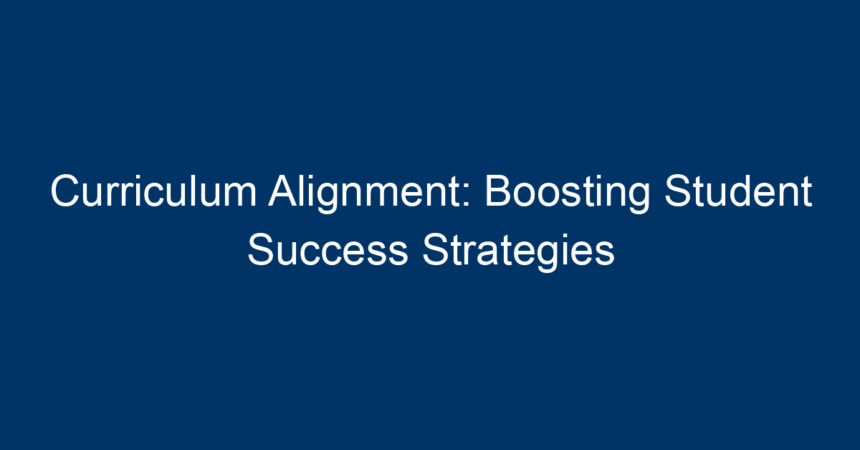Introduction
In today’s educational landscape, the concept of curriculum alignment is more important than ever. Schools and educators are continually seeking effective strategies to enhance student success, and aligning the curriculum with learning objectives is a powerful approach. But what exactly does curriculum alignment entail, and how can it be leveraged to help students achieve their full potential? In this comprehensive article, we will explore the nuances of curriculum alignment, its benefits, implementation strategies, and actionable insights that can lead to enhanced educational outcomes.
What is Curriculum Alignment?
Curriculum alignment refers to the systematic coordination of curriculum, assessment, and instruction to ensure that students achieve specific learning outcomes. This process encompasses three main components:
-
Curriculum Mapping: This involves mapping educational content and standards to understand what is taught, when, and how.
-
Assessment Integration: Aligning assessments to curriculum goals ensures that evaluations measure the skills and knowledge that the curriculum aims to foster.
- Instructional Strategies: Developing teaching methods that complement the aligned curriculum and focus on student engagement.
By ensuring that these elements are in sync, educators can create a cohesive learning environment that promotes student success.
The Importance of Curriculum Alignment
Enhanced Learning Outcomes
One of the most significant benefits of curriculum alignment is improved student learning outcomes. When the curriculum is aligned, assessments are directly tied to what students are taught, enabling them to grasp concepts more effectively. Studies indicate that well-aligned curricula lead to higher student performance on standardized tests.
Increased Engagement and Motivation
Aligned curricula are typically more relevant and engaging for students. When learners understand the connection between what they are being taught and real-world applications, their motivation increases. This engagement can lead to a deeper understanding of the material and better retention of knowledge.
Streamlined Instruction
Curriculum alignment allows teachers to streamline their instructional methods. When educators know that they are working within a framework that connects lessons to assessments and student expectations, they can focus their efforts on delivering high-quality instruction. This reduces wasted time and resources, creating a more efficient learning environment.
Strategies for Effective Curriculum Alignment
1. Collaborate with Stakeholders
Engaging various stakeholders—including educators, administrators, and even students—can provide diverse perspectives on curriculum alignment. Forming committees or working groups can help develop a more comprehensive approach that meets the needs of all learners.
2. Utilize Data-Driven Decision-Making
Data is a crucial element in evaluating curriculum effectiveness. By analyzing student performance data, educators can identify gaps in learning and make informed adjustments to their curriculum. This data-driven approach ensures that curriculum alignment is not just a theoretical exercise but a practical one grounded in student outcomes.
3. Implement Backward Design
Backward design is an instructional planning method that starts with the end goals in mind. By first identifying desired learning outcomes, educators can design curriculum content and assessments that align with those goals, ensuring a clear pathway for student success.
4. Continuous Professional Development
Investing in professional development for educators is vital for effective curriculum alignment. Workshops, training sessions, and collaborative planning time can equip teachers with the skills and strategies they need to implement aligned curricula effectively.
5. Embrace Technology and Resources
The use of educational technology can facilitate better curriculum alignment. Tools like Learning Management Systems (LMS) and curriculum mapping software can help track progress, assess alignment, and enable communication among educators.
Challenges in Curriculum Alignment
Time Constraints
One of the most significant hurdles to curriculum alignment is the time required for planning and collaboration. Educators often juggle multiple responsibilities, making it challenging to dedicate sufficient time to align their curriculum effectively.
Resistance to Change
Some educators may resist new alignment strategies due to comfort with established teaching practices. Overcoming this resistance takes effective leadership and clear communication about the benefits of curriculum alignment for student success.
Evaluation and Assessment Limitations
Achieving true curriculum alignment requires robust evaluation methods. However, standardized tests often fail to measure the full range of student skills and knowledge. Aligning curricula with assessments that provide a comprehensive evaluation of student learning is crucial.
The Future of Curriculum Alignment
As education continues to evolve, especially with the advent of technology and personalized learning, the importance of curriculum alignment will only grow. Emerging trends like competency-based education and project-based learning are reshaping how alignment is perceived and implemented.
To remain effective, educators must stay informed about best practices and emerging trends in curriculum development. Developing curricula that not only meet current standards but also prepare students for future challenges will be paramount.
Actionable Insights for Educators
-
Start Small: Begin by aligning specific units or subjects before expanding the alignment efforts across the entire curriculum.
-
Pilot Programs: Test new alignment strategies in a controlled environment. Use data from pilot programs to refine your approach.
-
Engage Students: Incorporate student feedback into the alignment process. Understanding their perspectives can provide valuable insights.
-
Create Resources: Develop a repository of aligned materials and strategies that can be shared among educators, fostering a collaborative learning culture.
- Monitor Progress: Consistently assess the effectiveness of your curriculum alignment efforts and make necessary adjustments based on data and feedback.
Conclusion
Curriculum alignment is a crucial strategy for boosting student success in today’s rapidly changing educational landscape. By ensuring that curriculum, assessment, and instruction are in sync, educators can create a cohesive and engaging learning environment that promotes better outcomes for all students. Though challenges exist, implementing effective strategies and continuously refining practices can lead to significant improvements in educational achievements. As we advance, embracing the principles of curriculum alignment will be key to preparing students for the future.
By taking actionable steps toward curriculum alignment, educators can help students thrive academically, socially, and emotionally, ultimately leading to a more successful and fulfilling educational experience.




